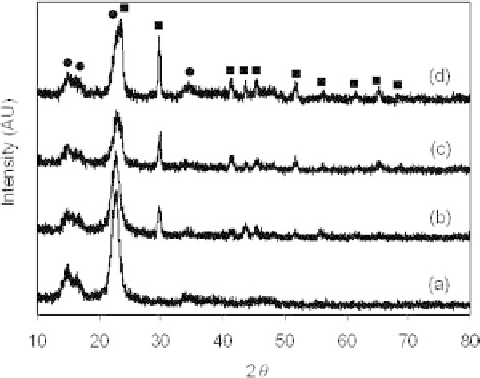Biomedical Engineering Reference
In-Depth Information
The main synthetic approach for preparing selenium nanoparticles is through chemical
reduction. Several other methods including
γ
-irradiation and laser ablation have also
been applied to synthesize selenium nanoparticles (59, 60).
The synthesis of uniform hexagonal selenium nanoparticles involves an
in situ
reduc-
tion of H
2
SeO
3
by CNXL under hydrothermal conditions. In this approach, CNXL
serves as both a reductant and a structure-directing agent. Hydroxyl groups on the
CNXL surface immobilize selenium ions (selenite) and allow them to form selenium
nanoparticles upon reducing at elevated temperature (61). In this synthetic process,
Na
2
SeO
3
is hydrolyzed to form selenious acid (H
2
SeO
3
) in an acidic CNXL solution
(pH
2
.
7). The selenious acid was isotropically distributed on CNXL colloids. Subse-
quent hydrothermal treatment induced surface reduction of selenious acid to elemental
selenium. Figure 12.10 shows the XRD traces of samples prepared with CNXL at dif-
ferent temperatures over a time of 16 h. The diffraction peaks at 2
θ
=
∼
15
.
1, 16.8, 22.5,
and 34
.
1
◦
are for CNXL, and those at 23.7, 29.8, 41.4, 43.9, 45.5, 51.8, 56.3, 61.9,
65.2, and 68
.
6
◦
are for the (100), (101), (110), (102), (111), (201), (112), (202), (211),
and (113) reflections of the pure hexagonal phase of selenium with lattice parameters
a
4
.
948 A (JCPDS 06-0362). The crystallinity of CNXL was main-
tained to 200
◦
C under hydrothermal conditions. At 100
◦
C, the diffraction peaks of
CNXL were dominant with a negligible (101) peak of Se at 29
.
8
◦
. At 120
◦
C, six new
diffraction peaks emerged at 2
θ
values of 29.8, 41.4, 43.9, 45.5, 51.8, and 56.3, and the
CNXL peaks also remained evident. It was apparent that the intensities of the selenium
peaks gradually increased when the reaction temperature was increased to 160
◦
C. These
new peaks were originated from hexagonal selenium. Thus, the formation of the hexag-
onal selenium phase is considered to begin at about 100
◦
C in this experiment. No other
4
.
367 A, and c
=
=
Figure12.10
XRDpatternsofCNXL-supportedseleniumparticlespreparedunderhydrother-
mal conditionat different temperatures: (a) 100, (b) 120, (c) 140, and (d) 160
◦
C.
•
denotes
celluloseand
denoteselementalselenium(reprintedwithpermissionfromref61).Copyright
2007Elsevier.

Search WWH ::

Custom Search